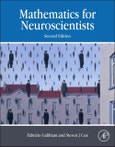Mathematics for Neuroscientists, Second Edition, presents a comprehensive introduction to mathematical and computational methods used in neuroscience to describe and model neural components of the brain from ion channels to single neurons, neural networks and their relation to behavior. The book contains more than 200 figures generated using Matlab code available to the student and scholar. Mathematical concepts are introduced hand in hand with neuroscience, emphasizing the connection between experimental results and theory.
Please Note: This is an On Demand product, delivery may take up to 11 working days after payment has been received.
Table of Contents
1. Introduction 2. The Passive Isopotential Cell 3. Differential Equations 4. The Active Isopotential Cell 5. The Quasi-Active Isopotential Cell 6. The Passive Cable 7. Fourier Series and Transforms 8. The Passive Dendritic Tree 9. The Active Dendritic Tree 10. Extracellular Potential 11. Reduced Single Neuron Models 12. Probability and Random Variables 13. Synaptic Transmission and Quantal Release 14. Neuronal Calcium SignalingNeuronal Calcium Signaling 15. Neurovascular Coupling, the BOLD Signal and MRI 16. The Singular Value Decomposition and ApplicationsThe Singular Value Decomposition and Applications 17. Quantification of Spike Train Variability 18. Stochastic Processes 19. Membrane NoiseMembrane Noise 20. Power and Cross-Spectra 21. Natural Light Signals and Phototransduction 22. Firing Rate Codes and Early Vision 23. Models of Simple and Complex Cells 24. Models of Motion Detection 25. Stochastic Estimation Theory 26. Reverse-Correlation and Spike Train Decoding 27. Signal Detection Theory 28. Relating Neuronal Responses and Psychophysics 29. Population CodesPopulation Codes 30. Neuronal Networks 31. Solutions to Exercises








